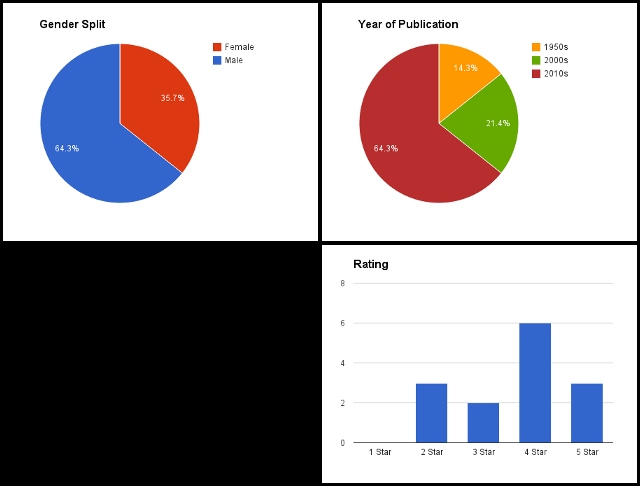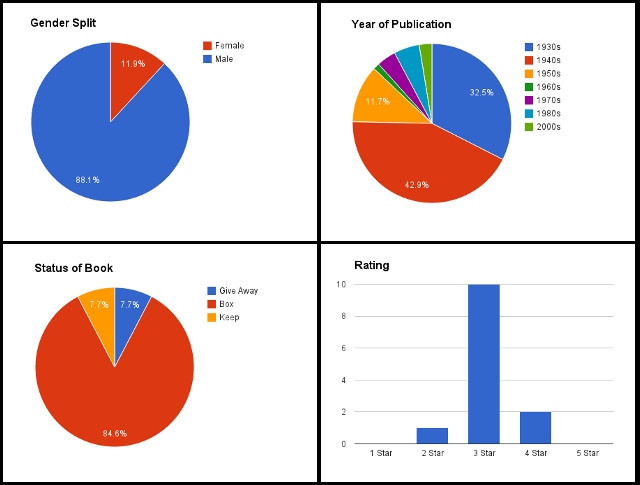The third & last episode of Treasures of Ancient Rome was about the art during the declining years of the Roman Empire. Alastair Sooke opened by explaining that the canonical view is that the art of this period is poor & gets worse over time because the Empire is falling to bits. He sets out to show in this episode that this isn’t true – the art style might change but it’s no less good than what came before.
He started in the city of Leptis Magna which is in Libya and was prominent in the later part of the Empire. Sooke characterised this period of Empire as the periphery becoming as important (if not more important) as the centre. Citizens from the periphery could even become Emperor – Septimus Severus, for instance, was from Leptis Magna. The city is very well preserved, so several of Sooke’s examples of art from this period were from the city or nearby. These included a triumphal arch & the basilica, both of which combine classical Roman motifs with local elements. There was also a stunning mosaic depicting gladiators from a nearby villa that was only relatively recently discovered & has just been put on display in a museum (I think this was my favourite piece from the programme). And Sooke also visited another villa in Libya that has been part excavated – but he was visiting not long after the overthrow of Gaddafi and the Libyan archaeologist who was showing him around was explaining that sites like this are being neglected (now & under Gaddafi’s regime) and the art & artifacts that have been uncovered are deteriorating due to the neglect. From Libya Sooke went to Egypt, to show us the famous mummy portraits. These aren’t wholly Roman nor are they classically Egyptian, the two art styles & symbolisms have been merged together. And they are hauntingly beautiful images of the people whose mummies they’re attached to.
The next few artworks were from the northern reaches of the Empire. He very briefly touched on the art at Bath, which is a fusion of Roman & Celtic art, but wasn’t very impressed. The stuff he did hold up as truely great pieces of art was some of the silverware that’s been found in Britain & other parts of the northern Empire. This includes the Mildenhall Great Dish which he looked at with a modern silversmith to talk about how technically accomplished it is (as well as being good art). In this segment he also showed us the Lycurgus cup, which is made of carved glass. In the light it looks like it’s red, but in shade it looks green – this effect has been achieved by including particles of silver & gold in the glass. I wasn’t that keen on the design of the cup, so it seemed more of an engineering achievement than a piece of art to me.
And he finished up the programme by talking about how the art of the later Romans became the art of Western Christianity. To illustrate this he first showed us the mosaics in the mausoleum for a Roman woman (Galla Placidia) which date from the early 5th Century AD, and then the later mosaics in the Basilica of San Vitale. As this dates from the late 6th Century AD it’s well after the end of the Roman Empire – but there’s definitely continuity between the two sets of decoration.
At the very end Sooke wrapped up the series by saying that he’d shown that the Romans should be famed for their art, not just their conquering. Having not seen the first one I’d not quite realised that was the premise! A good series, I’ll be looking out for more programmes from him.
One of the sorts of programmes that J & I look out for to record fit into a category we think of as “depressing current affairs” – and the recent BBC series about the Iraq War fits into that. The first episode looks at the road to war, starting in September 2001 and following the politics & intelligence service actions for the next 18 months. The bulk of the programme is interviews with the senior people involved, not just from the US & the UK but also from Iraq. And I mean really senior – for the UK the people interviewed included Tony Blair & Jack Straw, among the US interviewees were Dick Cheney & Colin Powell.
The story the programme told was the now familiar one – in retrospect it’s clear that the decision to effect regime change was made and then intelligence was gathered to justify it rather than the decision coming after the data. It opened with something I’d not heard before that after Bush did his “you’re either with us or with the terrorists” speech the Iraqi government (in the person of the Prime Minister I think) were poised to reply that Iraq would join the fight against al Qaeda. But then Saddam Hussein countermanded that & said he’d reply himself – and tried to turn it into “we’ll help if you drop your sanctions”. So that put up the US government’s collective backs, and regime change seemed like the obvious way forward.
I’m not going to attempt to re-cap this programme, instead I’ll just mention a couple of the other things that particularly struck me (other than how self-serving Blair always comes across as …). First was a thought sparked by the current/recent situation in Egypt. There’s been a fair amount of talk in the media about how the US is having to dance an interesting diplomatic dance where they can’t regard the military intervention as a coup because coups are Always Bad Things and they don’t want to condemn this particular one just yet. Yet the attempts by the US intelligence services to figure out a way to engineer a coup in Iraq were being held up as the moral thing to do without even a figleaf of pretence that ceci n’est pas un coup d’etat. So coups are Always Bad unless either we like you better then we’ll call it something else or we organise it ourselves coz then it’s Good. Glad we got that straight 😉
One piece of the intelligence that was used to justify the war stood out to me as a particularly revealing about the way things were handled – this was the information from a French journalist/informer who had access to the Iraqi Foreign Minister. He told the CIA that the Iraqi man was wanting to defect & that he confirmed that Iraq had WMD. The CIA were concerned to make sure the journalist really did meet with the man he said he was talking to – so there was some business with custom made suits and an appearance at the UN in one of them. But despite being suspicious enough to run that test, once he’d passed that test then it was just assumed he was telling the truth about everything. Not that it was 100% confirmed but everyone interviewed was clear that it coloured the way they looked at everything else. So “definitely met him” was turned into “probably telling the truth about the conversation” very quickly, not for any reason except that the reported conversation fit the desired answer. Which is why you shouldn’t make your decisions first then fact gather to justify them! Hard enough to avoid bias normally, let alone when the President’s busy saying “I want to do this, now make a case for why I can”.
Of course the thing about a programme like this is that hindsight is always 20/20. The bias of the narrative was that people should’ve known better but that doesn’t mean they were cynically ignoring things or falsifying intelligence. Good intentions don’t outweigh the mistakes, but it’s better than having bad intentions as well!
The second episode covered the immediate aftermath of the war. The familiar story here is that while the US had a plan for the war, they didn’t have a plan for the peace – this programme showed how that lack of foresight played out. Again I’m not going to do a full recap, just pull out some things that particularly caught my attention (so there’s definitely important events missing from my write-up that the programme did discuss).
After Saddam was deposed & the war “won” because there was no plan there was a power vacuum, which the first man on the ground (Jay Garner) did his best to fill. He was a retired US General who had worked with the Kurdish leaders in the past – so known to them & respected by them – and he got them together with the Iraqi opposition leaders who’d been in exile. Garner’s plan was to have them form themselves into an interim government very quickly, then they’d sort out a constitution and elections afterwards. For political reasons & because the situation looked poor (because it was) he was replaced by Paul Bremer.
And that’s where the slide downhill begins. Hard to say if it would really have ended up differently had Garner been in charge, his plan wasn’t well received by all Iraqis, but it certainly seemed like Bremer caused a lot of the later problems. I was particularly struck by him setting up his office in one of Saddam’s old palaces … it seems the sort of symbolism you’d want to avoid. He then follows up by telling the proto-government that Garner was trying to assemble that they’re not diverse enough to represent the whole of Iraq (true, but …) and so he’s the one who’s in charge not them. Coz obviously it’s better to have a random US diplomat who knows no-one & no-one knows. Maybe he was a better choice, but handling it like that seemed designed to put everyone’s back up.
And then there’s the debacle with the Iraqi army. The plan, laid out by Bush, was “don’t disband the army, putting 300,000 or so trained men with weapons on the streets seems a bad idea”. Bremer … failed to pay the army and then disbanded it. The payment thing was particularly eye-rolling in my opinion – there was a disbursement of wages to civil servants etc from the old regime, $20 each which was about 6 months wages. But nothing for the army because why should they pay what Saddam had failed to pay them? So after disbanding the army they had a large number of well trained & organised men who felt disrespected & dishonoured, and who had no money to buy food for their families. Not surprisingly a lot found their way instantly into the various insurgency groups & that’s when the real violence against the US & their allies kicked off.
The handover of power got further complicated because the main Shia cleric, Grand Ayatollah Sistani, issued a fatwa saying that elections should come before the constitution – i.e. that the constitution would be written by elected Iraqis not people chosen by the US. Seems simple enough, but Bremer had a hard deadline of “before Bush runs for President again” and that wasn’t time to get elections organised. The US administration of Iraq is therefore more concerned with how it looks in US domestic politics than whether it’s the best for the country they’re running … In the end Bremer just appointed someone to be Prime Minister and other people to be the government, which is directly against the fatwa that the Grand Ayatollah had issued and so is guaranteed to piss off the people who regard Sistani as their spiritual leader (i.e. the Shia Muslim majority of Iraqi citizens).
So now they have the army against them, the Shia Muslim authorities & believers against them plus the people who’d never been going to be with them. Maybe there were no good solutions once the war was won. One of the interviewees on the programme was a Sunni cleric who’d been leading an insurgency group since day 1 of the aftermath – he was quite clear that he’d not considered doing anything but fight the US. But even if it was hopeless, the way the post-war US administration acted didn’t help, and actively made things worse.
For something a little more light-hearted we finished off the series of TOWN with Nicholas Crane. This episode was about Enniskillen, which is on an island in a lake in Northern Ireland. Of course, as with a lot of places in Northern Ireland, the history of the town wasn’t terribly light-hearted. The oldest building is a castle that was built by Hugh the Hospitable in the early 15th Century, due to the strategically important location it was a target of the English when they were conquering & subduing Ireland in the 16th & 17th Centuries. Fast-forward to the modern day & The Troubles, and Enniskillen was the place where the Remembrance Day Bombing took place in 1987 killing 11 people.
The town is built around a single street running right across the island – it actually has 6 different names along the route, but that seems fairly arbitrary. Crane walked down this in a rather padded-out segment of the programme when he was making a big deal about how many independent stores there were on the street (and how they were clustered in types). The camera didn’t linger on the chain stores, but we still spotted them 😉 There were some interesting shops tho – particularly the butcher’s shop where they are so keen to ensure the quality of their bacon that they’ve purchased a nearby island to let their pigs roam free (until butchered).
The “future of the town” section concentrated on the fact that shale gas has been discovered in the area, and so there are starting to be plans for fracking to take place. I can see why people are concerned about this (“we’ll just explode the rock under your town a little” doesn’t exactly inspire confidence), but I did raise my eyebrows somewhat at the repeated allusions to The Troubles in this bit (not by the people, but by the programme). Crane said a couple of times that “the town needed to all come together against this just like they did during The Troubles”, which I suppose was like calling on Londoners to display Blitz Spirit during some later event … but it just felt a bit off to be comparing mining for gas (however intrusive) with killing people.
Overall the series was … OK. While we did watch all of it I wouldn’t say it was a favourite and I don’t think I’ll bother recording a further series.



